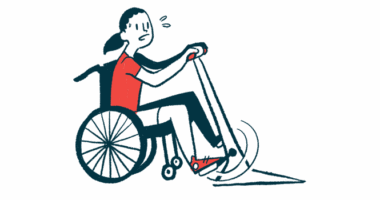Grip strength may be better test of subtle upper limb changes in SMA
Standard RULM test found limited in ability to capture changes in SMA type 3

Measures of grip strength or mobility may help to capture subtle changes in upper limb function for children with spinal muscular atrophy (SMA), particularly for patients who are overall less severely affected, according to findings from a recent study.
The Revised Upper Limb Module (RULM), which is a standard measure of general upper limb function, was found to be limited in its ability to capture changes in children with SMA type 3 who retained their ability to walk (ambulatory).
Conversely, measures of hand/finger grip and hand mobility could capture upper limb changes across disease subtypes, and correlated with RULM performance.
“With the emergence of new therapies, the importance of capturing changes in all the cohorts of patients becomes essential to assess efficacy in the upper limb,” researchers wrote.
Study results can help guide clinicians in treating SMA patients
“Our results can guide clinicians toward a better interpretation of the changes in the upper limb function and its correlations with strength and hand/finger mobility, before and after treatments,” researchers noted.
The study, “Assessment of the upper limb function, strength, and mobility in treatment-naive children with spinal muscular atrophy Types 2 and 3,” was published in Muscle & Nerve.
Over time, muscle weakness contributes to a loss of upper limb function for SMA patients. This is traditionally assessed with RULM, a series of clinically administered tests of upper limb function and strength where a decreasing score reflects declines in upper limb function.
However, while RULM may be useful for monitoring more severely affected patients, it does not adequately capture upper limb function in those with higher physical function, namely those with SMA type 3 who remain ambulatory, studies suggest.
“Because treatments are changing the natural history trajectories of patients with SMA, there is a need for a more holistic approach to help clinicians better understand the progression of upper limb symptoms in this population,” the researchers wrote.
Other assessments, such as those of hand and grip strength, can help to detect more subtle changes in function and may be useful for monitoring upper limb function in less severely affected patients. Still, evidence is lacking as to how these measures change over the natural course of SMA, and the degree to which they correlate with RULM performance.
Because treatments are changing the natural history trajectories of patients with SMA, there is a need for a more holistic approach to help clinicians better understand the progression of upper limb symptoms in this population.
Study examined upper limb function in 19 children with SMA types 2 and 3
In their study, researchers examined changes in upper limb function across a series of tests over a one-year period among 19 children with SMA types 2 and 3, ages 5-18, who were seen at their clinic in London. Ten patients had SMA type 2, and nine had SMA type 3, with four of them being ambulatory.
Along with RULM, assessments of hand/finger mobility, and grip and pinch strength were conducted. Grip and pinch were evaluated via a technique called dynamometry, which uses a device that measures force during a motion as an indicator of strength.
Across all participants, a median decline of two points on the RULM scale was observed, but differences were seen according to age and disease subtype.
For example, the greatest declines were observed in children ages 10-14 (median 2.5 points), whereas children ages 5-9 saw the smallest declines (median 1 point).
Ambulant SMA type 3 patients had the highest RULM performance at the study’s start and showed a slight improvement over time, whereas non-ambulatory type 3 patients and those with type 2 showed a median decline of two points.
Moreover, two of the four ambulatory patients reached a RULM ceiling, where their performance could no longer improve any further, and thus that scale would no longer be able to capture meaningful changes in upper limb function over time.
“Our results [confirm] the limitations of the RULM scale for the ambulant SMA Type 3 children, ” the researchers wrote. “This indicates the need for additional outcome measures to record subtle changes in the upper limb.”
Grip strength test identified more subtle changes in upper limb function
Indeed, more subtle changes in function were identified in the grip strength test, where performance declined across all three disease subtypes.
On the other hand, pinch strength improved over the one-year period for children with all disease subtypes, as did hand/finger mobility scores. For these measures, some differences were also again observed by age group.
Scores on these various upper limb function assessments correlated with one another. Specifically, higher performance on RULM significantly correlated with better grip and pinch strength. Grip and pinch strength were also significantly correlated with one another.
Given their ability to capture functional changes across the disease spectrum and their correlation to RULM performance, the findings support the addition of dynamometry measures in future studies of SMA patients, according to the scientists.
Such measures could be used to assess how well an investigational treatment is working for improving upper limb function. “Future research in treated patients is needed to explore our findings,” the team concluded.









